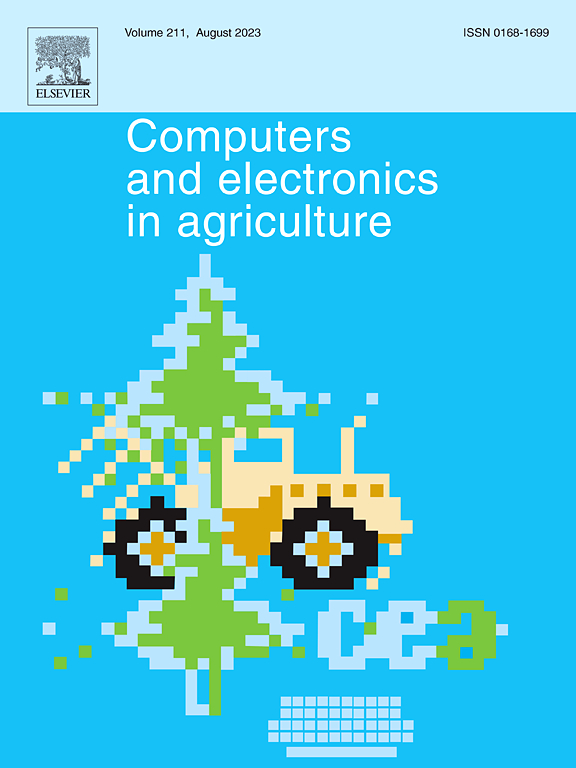一种监测黑棉螟害虫胁迫水平的植被指数
IF 8.9
1区 农林科学
Q1 AGRICULTURE, MULTIDISCIPLINARY
引用次数: 0
摘要
该研究提出了一种新的植被指数(DCBVI)来有效监测暗棉虫的侵害,解决了现有指数对暗棉虫侵害敏感性低的局限性。采集棉花花期和铃期2年多的非成像高光谱数据和无人机多光谱数据,计算各高光谱波段的一阶微分值。利用Pearson相关系数和Relief-F算法,选择了与暗色棉蚧昆虫胁迫相关的高光谱波段。基于差值、比值、归一化和叶绿素植被指数构建了4个新的植被指数。选取与害虫胁迫相关性最强的植被指数,命名为暗棉虫植被指数(DCBVI)。结合现有植被指数,利用GDLR、SVM和CatBoost构建暗棉虫病虫害胁迫分类模型,并利用无人机多光谱遥感数据的相关波段导出DCBVI。建立了棉铃虫害虫判别模型,并对棉田害虫分布进行了可视化分析。为研究黑棉虫侵染对棉花生长的影响,利用KNN、RF和CatBoost建立了不同侵染程度的SPAD反演模型。采用萤火虫算法(FA)、蝙蝠算法(BA)和遗传算法(GA)对暗色棉铃虫侵染的分类判别模型和棉花SPAD反演模型进行了优化。结果表明,DCBVI与暗色棉铃虫虫害胁迫水平的相关系数为0.833,与SPAD的相关系数高于现有植被指数。基于DCBVI和现有植被指数进行FA优化的CatBoost暗棉虫害虫分类模型的正确率、精密度、召回率和F1得分分别达到93.1%、93.2%、92.9%和92.8%。采用BA-CatBoost模型反演不同虫害胁迫下褐棉小棉铃虫SPAD值,最优模型的R2和RMSE分别为0.949和1.619。本研究显著提高了棉铃虫监测的准确性,并为构建基于高光谱数据的其他害虫监测灵敏度指数提供了一种新的方法。本文章由计算机程序翻译,如有差异,请以英文原文为准。
A novel vegetation index for monitoring the stress levels of pest caused by dusky cotton bug
The research introduced a novel vegetation index (DCBVI) to effectively monitor dusky cotton bug infestations, addressing the limitations of existing indices, which show low sensitivity to these infestations. Non-imaging hyperspectral data and UAV multispectral data of the cotton canopy were collected during the flowering and boll development stages over two years, and the first-order differential values of each hyperspectral band were calculated. The Pearson correlation coefficient and Relief-F algorithm were used to select the hyperspectral bands associated with insect stress caused by the dusky cotton bug. Four novel vegetation indices were constructed based on difference, ratio, normalization and chlorophyll vegetation index. The vegetation index most strongly correlated with insect pest stress was selected and designated as the Dusky Cotton Bug Vegetation Index (DCBVI). Combined with the existing vegetation indices, GDLR, SVM and CatBoost were used to construct the pest stress classification model of dusky cotton bug, and DCBVI was derived using relevant bands from UAV multispectral remote sensing data. The pest discrimination model for the cotton bug was established, and the pest distribution in cotton fields was visualized. To research the effect of dusky cotton bug infestation on cotton growth, SPAD inversion model for different infestation levels were established by KNN, RF and CatBoost. The Firefly algorithm (FA), Bat algorithm (BA), and Genetic algorithm (GA) were used to optimize both the classification and discrimination models for dusky cotton bug infestation and the cotton SPAD inversion model. The results showed that the correlation between DCBVI and the pest stress level of the dusky cotton bug was 0.833, and the correlation between DCBVI and SPAD was higher than that of existing vegetation indices. The accuracy, precision, recall, and F1 score of the CatBoost dusky cotton bug insect pest classification model, optimized by FA based on DCBVI and the existing vegetation index, reached 93.1%, 93.2%, 92.9%, and 92.8%, respectively. When the BA-CatBoost model was used to invert the SPAD values of the dusky cotton bug under different insect stress, the R2 and RMSE of the optimal model were 0.949 and 1.619. This research significantly improves the accuracy of dusky cotton bug pest monitoring and provides a method for constructing a novel sensitivity index based on hyperspectral data for monitoring other insect pests.
求助全文
通过发布文献求助,成功后即可免费获取论文全文。
去求助
来源期刊

Computers and Electronics in Agriculture
工程技术-计算机:跨学科应用
CiteScore
15.30
自引率
14.50%
发文量
800
审稿时长
62 days
期刊介绍:
Computers and Electronics in Agriculture provides international coverage of advancements in computer hardware, software, electronic instrumentation, and control systems applied to agricultural challenges. Encompassing agronomy, horticulture, forestry, aquaculture, and animal farming, the journal publishes original papers, reviews, and applications notes. It explores the use of computers and electronics in plant or animal agricultural production, covering topics like agricultural soils, water, pests, controlled environments, and waste. The scope extends to on-farm post-harvest operations and relevant technologies, including artificial intelligence, sensors, machine vision, robotics, networking, and simulation modeling. Its companion journal, Smart Agricultural Technology, continues the focus on smart applications in production agriculture.
 求助内容:
求助内容: 应助结果提醒方式:
应助结果提醒方式:


